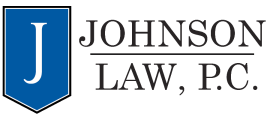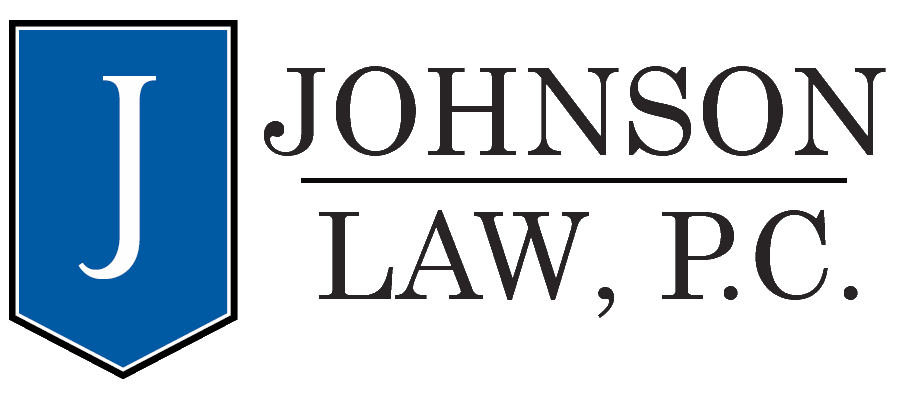Car Accident Example Descriptions
Updated: 1/2/2025
If you need immediate legal help contact us now or read our post-accident guide here. This post is to be used after a car accident. These car accident example descriptions can help you describe your own accident.
Here are some of the types of questions that this blog post answers:
How do I describe my car accident?
What is a ______ collision?
What types of injuries should I be worried about?
Who is at fault in a ______ collision?
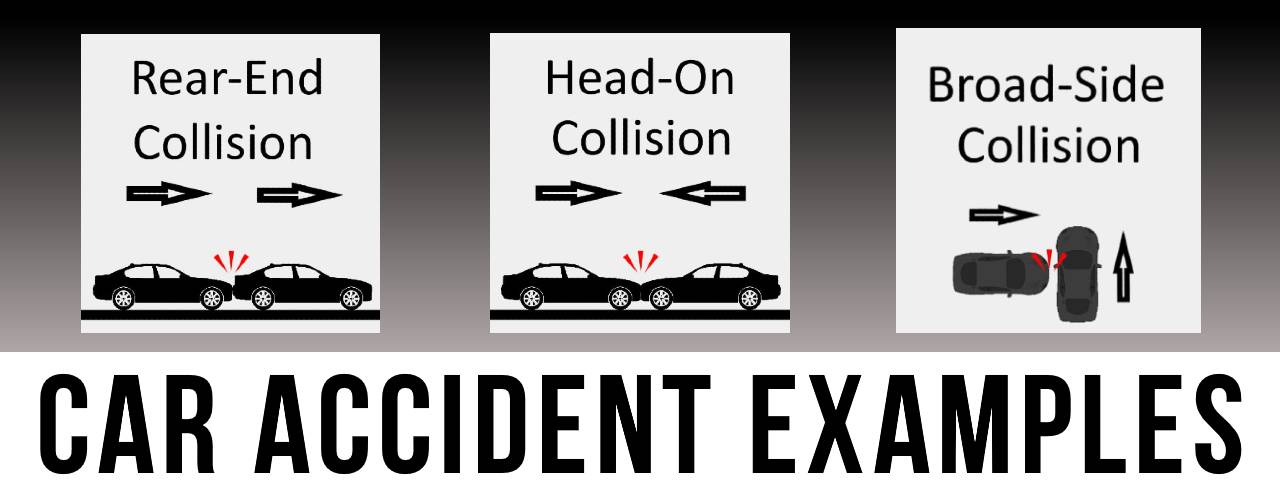
These are questions we are happy to answer for you. You can call us (971-205-3266) for a free consultation or continue reading. Please note, that this blog post only aims to discuss two-vehicle collisions. More information can be found on each collision type in additional blog posts or on our practice areas pages.
Good Car accident example descriptions
The best car accident description needs to answer a few questions. This is because law enforcement, insurance agencies, lawyers, and others will need most if not all of these questions answered. Giving a good description of your accident can save you time and money.
Let's go over the questions.
First, where did the accident take place? Try to pinpoint where each vehicle was.
Less useful example: "I was in a car crash in Beaverton"
Good example: "The accident happened at the intersection of Third St. and Washington Ave. My car was traveling north along Washington Ave., their car was traveling west along Third St."
Second, when did the accident take place? The exact time can be useful.
Less useful example: "The crash was sometime in August last year"
Good example: "The crash happened on August 31st, 2021 at 2:00 in the afternoon."
Third, how did the accident happen? In what way did the cars hit each other and why?
Less useful example: "They hit my car, it wasn't my fault."
Good example: "The other driver rear-ended me. I was at a complete stop. They admitted to being distracted by their phone"
Fourth, what damages were caused by the accident?
Less useful example: "My car is pretty messed up, and so is my leg. My life has been crazy after the accident."
Good example: "My car was considered totaled by insurance. The accident also crushed my leg breaking it. I can walk again, but I'm going through rehab and have not been able to work. To top things off, I also now get anxious in a car. I haven't been able to drive since."
Injured in a Head-On Collision
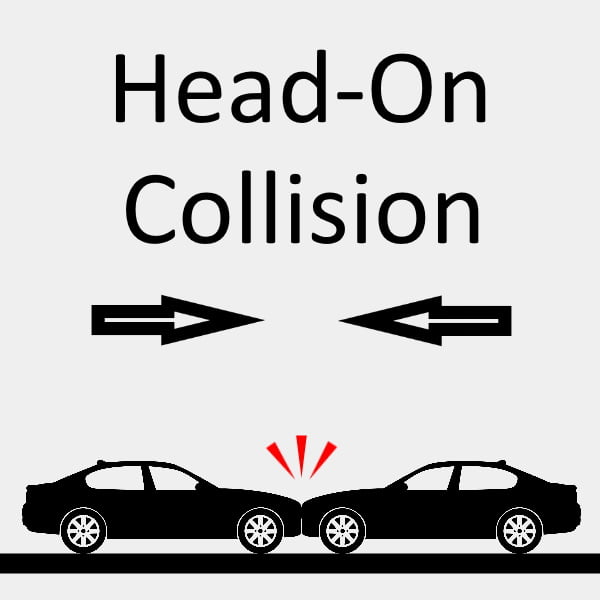
Car accident example descriptions (Head-On Collision)
Here is a sample head-on collision description:
"I was in a head-on collision. It happened on Highway 26 on August 31st, 2022 around 2:00 P.M. There was an animal in the opposing lane of traffic. The other vehicle swerved into my lane hitting me. My car was totaled and I suffered a broken leg and concussion. I also lost my job."
This is a good description because the description answers these questions:
- Where did the accident happen?
- When did the accident occur?
- How did the accident happen?
- What damages did it cause?
What is a head-on collision?
Also known as a frontal crash, a head-on collision is a traffic accident where the front ends of two vehicles, usually cars, SUVs, or trucks in the case of personal injury cases, hit each other when traveling in opposite directions. The “heads” of two vehicles collide.
Who is at fault in a head-on collision?
Typically, one driver will be traveling in the wrong direction of travel and will be at fault. However, the details will determine negligence. During a consultation, a lawyer can better answer this question based on the details you provide.
How much can I get for a head-on collision?
Head-on collision payouts are determined by a combination of fault, injury severity, and details that factor into pain and suffering calculations.
What injuries are common in a head-on collision?
Head-on collision injuries often include fractured bones in the ribs, arms, and legs. They are the collision most likely to result in severe injury or death. Life-threatening conditions are common such as traumatic injury to the brain, spinal cord trauma resulting in paralysis, and crushed organs bleeding internally.
It’s important to seek medical attention. Talk with a medical professional regarding the symptoms you are experiencing and the injuries you sustained. Protect your personal and financial health.
Other Information
In a head-on collision, the vehicles are headed in opposite directions. The result is a higher effective ΔV (collision speed). A higher effective collision speed means more injury and damage. This collision type is also often referred to as a frontal collision.
Injured in a Rear-End Collision
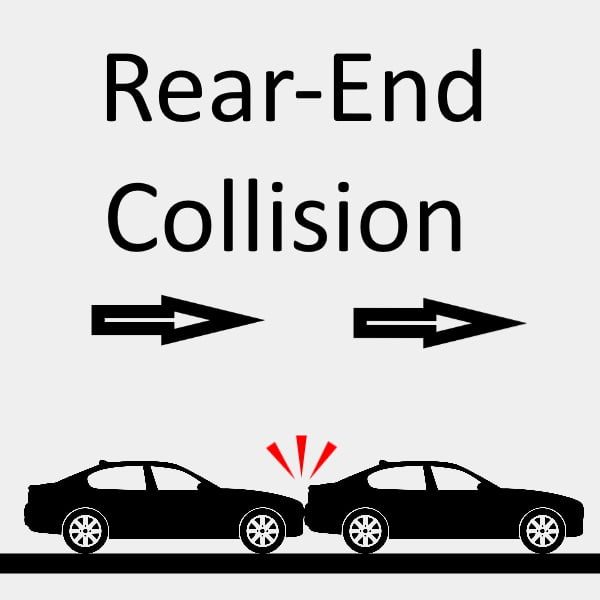
Car accident example descriptions (Rear-end Collision)
Here is a sample rear-end collision description:
"I got rear-ended last Tuesday. It was around noon when I was going to grab lunch. I was driving north along 185th and stopped at the Evergreen intersection. The other driver admitted to being distracted by their phone. I went to the emergency room and had a concussion, and ended up missing work for a week. "
This is a good description because the description answers these questions:
- Where did the accident happen?
- When did the accident occur?
- How did the accident happen?
- What damages did it cause?
What is a rear-end collision?
A rear-end is a traffic collision where the front of one vehicle hits the rear of another vehicle with both cars traveling in the same direction. The rear vehicle collides with the rear end of the lead vehicle.
Who is at fault in a rear-end collision?
Almost always the rear driver is at fault. However, the details determine who is at fault. During a consultation, a lawyer can better answer this question based on the details you provide.
How much can I get for a rear-end collision?
Rear-end collision payouts are determined by a combination of fault, injury severity, and details that factor into pain and suffering calculations. Rear-end collisions can result in injuries that are complicated to properly value for an insurance company; another reason why you probably want to talk to us. We know how to help.
What injuries are common in a rear-end collision?
Rear-end collisions often result in injuries to the neck and back. They also can result in injury to joints such as your shoulders and hips. Furthermore, rear-end crashes can result in traumatic brain injury because of the force involved in the backward and forward motion of the head.
Talk with a medical professional regarding the symptoms you are experiencing and the injuries you sustained. It is important to seek prompt medical attention. Quick action can be needed to protect your personal and financial health.
Other Information
In a rear-end collision the vehicles are traveling in the same direction. The result can be a relatively low effective ΔV (collision speed), but not always. The mass/speed of the vehicles involved is important.
Injured in a Broad-Side Collision (T-Bone)
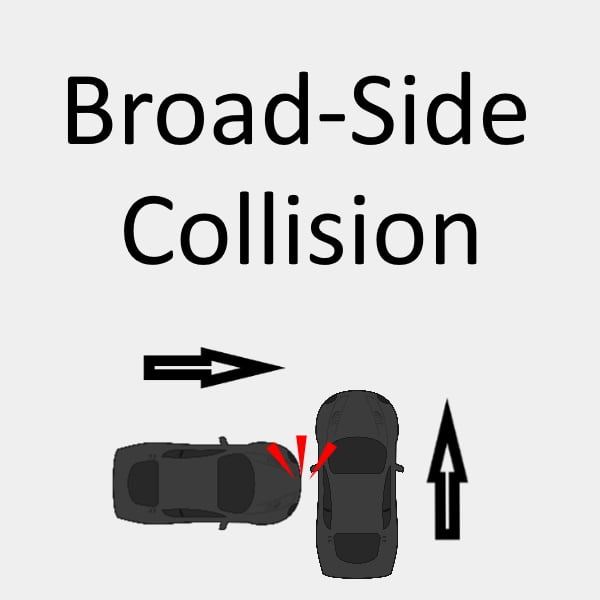
Car accident example descriptions (Broad-side Collision)
Here is a sample rear-end collision description:
"I was driving a friend's car and t-boned another vehicle while going through a green light. The other driver was taking a left turn while their traffic signal had a flashing yellow. They pulled out in front of me with no time to react. I have dash cam footage and both cars were totaled. I'm still getting treatment for my leg which was broken in the accident."
This is a good description because the description answers these questions:
- Where did the accident happen?
- When did the accident occur?
- How did the accident happen?
- What damages did it cause?
What is a broad-side or T-Bone collision?
A broadside collision is a traffic collision where the front of one vehicle hits the side of another vehicle with the vehicles traveling in perpendicular directions. The perpendicular directions of travel result in the cars creating a “T” shape, hence the name.
Who is at fault in a broad-side collision?
A T-bone collision is usually caused by one vehicle not properly adhering to traffic control at an intersection. Fault for the accident is usually determined by right of way according to Oregon’s traffic control device laws.
How much can I get for a broad-side collision?
Broad-side collision payouts are determined by a combination of fault, injury severity, and details that factor into pain and suffering calculations. How the crash impacts your life affects the potential payouts. You may not even realize how injuries can impact you down the road. We can help.
What injuries are common in a broad-side collision?
Broad-side collision injury is highly linked to vehicle size disparity, vehicle occupant location, and the speed of the crash. Injuries can be severe, including traumatic brain injury, shoulder/hip joint damage, bone fractures, and tearing of the spinal cord.
Do not wait too long to receive help. Quick action can help your personal health and financial recovery. Talk with a medical professional regarding the symptoms you are experiencing and the injuries you sustained.
Other Information
Broadside collisions often result in a vehicle rolling over. Rollover injury and vehicle damage will be highly dependent on vehicle type. A convertible would fare far worse than something like a Jeep with a roll cage. The terrain where the crash takes place also is very important. More damage may be caused by rolling down a hill than in the initial crash.
injured in a car accident - We Can Help
Johnson Law has experienced personal injury attorneys covering all the types of accidents listed above. Tell us your story and get the compensation you rightly deserve. Consultations are free and only a phone call away. Get in contact with an attorney immediately or schedule a time that works best for you.
We will review your case for free.
Pay us nothing unless we get you a better settlement.
We work on contingency.
